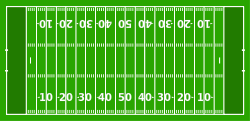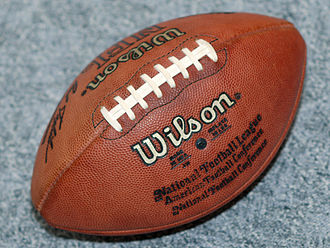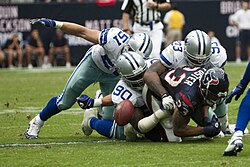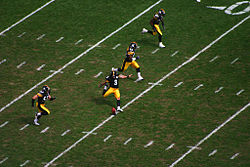American football
American football, referred to as football in the United States and Canada and also known as gridiron,[nb 1] is a team sport. It is played by two teams with 11 players on each side. American football is played with a ball with pointed ends. Points are scored in many ways, usually by one team getting the ball into the end zone of the other team. The game started in the late 19th century as college football, an American version of rugby football.
The main leagues that play American football are the professional National Football League (NFL), and the National Collegiate Athletic Association (NCAA), which plays college football. In the National Football League, players can be paid millions of dollars. In the National Collegiate Athletic Association, players simply play for the pride of their school, scholarships, or for the chance to join a national team. Over a million boys (and a number of girls) play high school football. There is also a closely related sport called Canadian football (CFL).
Gameplay
An American football game is played with a ball called a football. The sport is played on a grass (or artificial turf) field. The field is exactly 360 feet (110 m) long and 160 feet (49 m) wide. The end zones, one at each end of the field, are 10 yards (9.1 m) long. The players wear protective equipment, including a helmet with face mask, shoulder pads, thigh pads, and often a mouth guard. A team has four chances, or "downs", to advance the ball 10 yards (9.1 m) while the opposing team tries to stop it. Certain players advance the ball by carrying or throwing it. Teams can score by advancing the ball to the other team's end zone or by kicking the ball through a goalpost placed at the back of the end zone. American football is carefully regulated by time and rules, which are enforced by officials, who also determine when a team scores.
A college or professional football game is 60 minutes long, and is divided into 15-minute quarters. In some high schools, the quarters are 12 minutes long, and games for younger children are often shorter still. After the first two quarters, the teams rest during halftime.
In NFL football, if the game is tied after the four quarters, the two teams compete in at least one more 15-minute period called overtime. During overtime, the first team to score points is usually the winner. However, under the current rules, first used for the 2011 postseason, if the team that has the ball first ends its possession by scoring a field goal, the other team has a chance to score. If that team does not score, or if it scores a touchdown, the game ends. If it scores a field goal, the game continues, and the next team to score wins. During the regular season, only one overtime period is played—if neither team scores, or if both teams score field goals when they first have the ball, the game ends in a tie. During the playoffs, the game will continue with as many overtime periods as needed to decide a winner. If the game is tied after each team has had the ball once in overtime, the first team to score wins.
In NCAA football overtime, which is based on the system used for high school football in most U.S. states, the teams take turns trying to score. The game ends when one team scores, and the other team fails to score as many points during its chance.
Field
American football is played on a field 120 yards (110 m) long by 53.3 yards (48.7 m) wide. Most of the game is played on 100 yards (91 m) in the middle. It is divided by 20 lines drawn every 5 yards (4.6 m). The field has two other sets of markings, running between the two end zones along the length of the field, known as "hashmarks". All plays must start between the hashmarks—if the last play ended outside the hashmarks, the ball is moved to the nearest hashmark. At the ends of the field there are scoring areas, called the end zones.
There are also two yellow poles on the end of each field called uprights. Sometimes, if the team can not score a touchdown they might want to kick it through the uprights for three points. The uprights are also used for scoring one point after a team scored a touchdown.
Players
There are many types of players on a football team. For the offensive part of the team, a quarterback throws the football to wide receivers while offensive linemen block to protect him from defensive players. The offensive linemen also block when a running back runs to advance the football. Players on the Defensive line, a linebacker, and defensive backs (cornerbacks and American football safeties) attempt to tackle the offensive player who carries the football. Some team members only play during certain times. These players belong to the Special Teams. The kicker can kick the ball to the other team or between the uprights, while the placeholder holds the ball steady. The kick returner runs the ball down the field in an attempt to score points after catching the ball.
Scoring
Touchdown (6 points)
A touchdown is achieved when a player has legal possession of the ball and the ball crosses an imaginary vertical plane above the opposing team's goal line. After a touchdown, the scoring team attempts a try for 1 or 2 points (see below). A successful touchdown is signaled by an official extending both arms vertically above the head.
Field goal (3 points)
A field goal is scored when the ball is place kicked between the goal posts behind the opponent's end zone. The most common type of kick used is the place kick. For a place kick, the ball must first be snapped to a placeholder, who holds the ball upright on the ground with his fingertip so that it may be kicked. Three points are scored if the ball crosses between the two upright posts and above the crossbar and remains over.
Extra point (1 or 2 points)
Immediately following a touchdown, the scoring team can attempt to kick the ball between the goal posts for 1 extra point. The team can also run or pass the ball into the end zone for 2 points. This is not done very often, although it does happen if the game situation calls for it.
College football has unique rules regarding extra point attempts in overtime. Teams that score touchdowns are required to attempt a two-point conversion during the second overtime. Starting with the third overtime, the two teams alternate two-point conversion attempts, with the game ending when one team scores and the other does not.
Defensive conversion (2 points)
In the NFL, college football, and high school football in Texas (whose rules are based on the NCAA set), if the defense takes possession of the ball during an extra point (via fumble, interception, or blocked kick) and returns the ball into the opponent's end zone, the defensive team receives 2 points. (In high school football outside of Texas, if the defense takes possession during an extra point, the play is dead at that moment and the conversion is ruled "no good".)
Safety (2 points)
A safety is scored if a player causes the ball to become dead in his own end zone. When this happens two points are awarded to the opposing (usually defending) team. This can happen if a player is either downed or goes out of bounds in the end zone while carrying the ball. It can also happen if he fumbles the ball, and it goes out of bounds in the end zone. A safety is also awarded to the defensive team if the offensive team commits a foul which is enforced in its own end zone.
American Professional Seasons
Exhibition season
Exhibition season (better known as Pre-Season) is in August. In the exhibition season, the teams get ready for the regular season by having training. Teams have practices to help the team get better and see who will make the team. All of the teams play 3 games before the regular season starts, and the games do not change what team gets to the post season. Because of it, teams do not use their best players much, and use the games as more practice.
Regular season
The 32 NFL teams are divided into two conferences: the National Football Conference (NFC) and the American Football Conference (AFC). Each of them is divided in four divisions: North, South, West and East. Each division includes four teams. The season lasts 18 weeks. Each team plays 17 games and has one week off. This week of rest is called a "bye week".
NFL playoffs
At the end of the regular season, the winners of each division and the next three best teams in each conference play in a tournament. The NFC's champion and The AFC's champion play the NFL's final game, the Super Bowl. The event is often treated as a National holiday as many stores close for the event. The day of the event is commonly known nationwide as Super Bowl Sunday.
American Football Media
Walter Camp, the "Father of American Football", in 1878 when Camp was captain of Yale University's football team
The dangers associated with the sport depicted in a 1908 cartoon by William Charles Morris
Pudge Heffelfinger, widely regarded as the first professional football player
A diagram of a typical pre-snap formation. The offense (red) is lined up in a variation of the I formation, while the defense (blue) is lined up in the 4–3 defense. Both formations are legal.
A quarterback for the Kiel Baltic Hurricanes in Germany under center and ready to take the snap
Defensive players with the Dallas Cowboys forcing Arian Foster, a running back with the Houston Texans, to fumble the ball.
Kicker Jeff Reed of the Pittsburgh Steelers executes a kickoff
A player for the Navy Midshipmen (dark jersey) scores a touchdown while a defender from the Tulsa Golden Hurricane (in white) looks on. The goal line is marked by the small orange pylon.
The football field at The Dome at America's Center in St. Louis as seen from behind one end zone. The tall, yellow goal posts mark where the ball must pass for a successful field goal or extra point. The large, rectangular area marked with the team name is the end zone.
Related pages
References
- ↑ "Gridiron" Archived November 7, 2017, at the Wayback Machine, MacMillan Dictionary
- ↑ "gridiron football (sport)". Britannica Online Encyclopedia. britannica.com. Archived from the original on June 14, 2010. Retrieved July 13, 2010.
Notes
- ↑ The terms "gridiron football" and "gridiron" are sometimes used as synonyms for American football,[1] and are also sometimes used in a broader sense that includes Canadian football as well.[2]
Other websites
| Wikimedia Commons has media related to Lua error in Module:Commons_link at line 62: attempt to index field 'wikibase' (a nil value).. |













